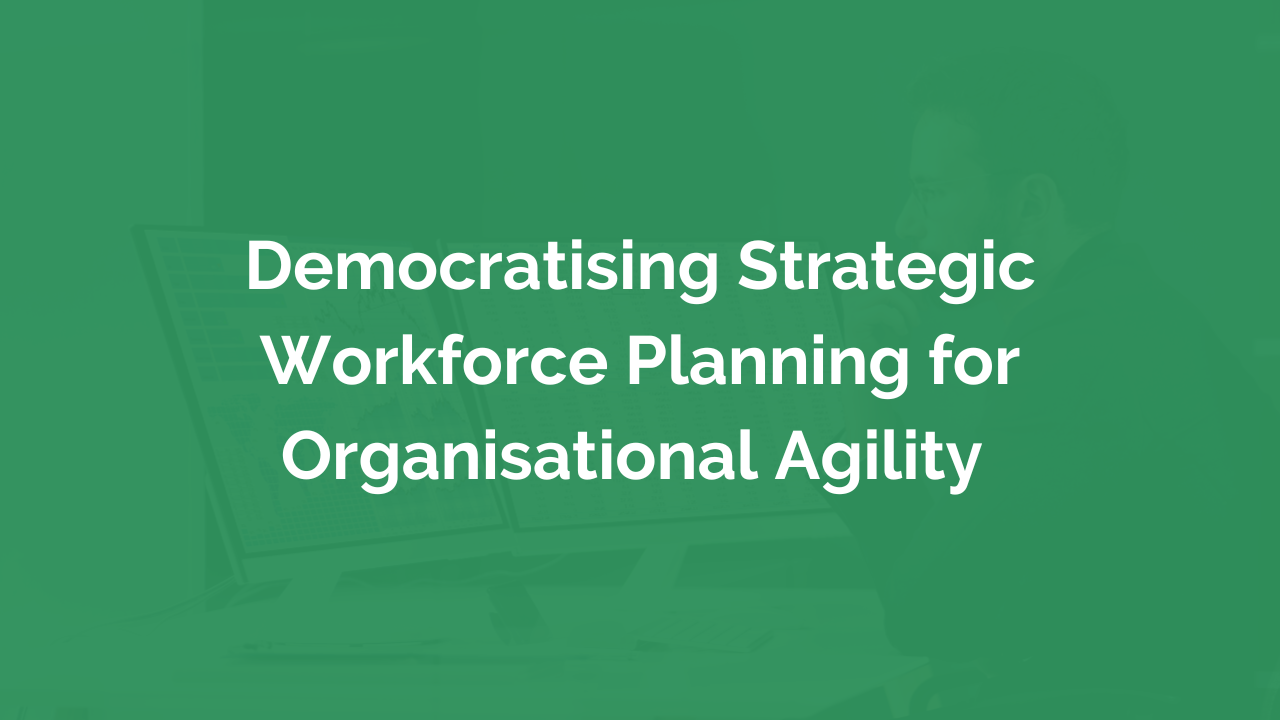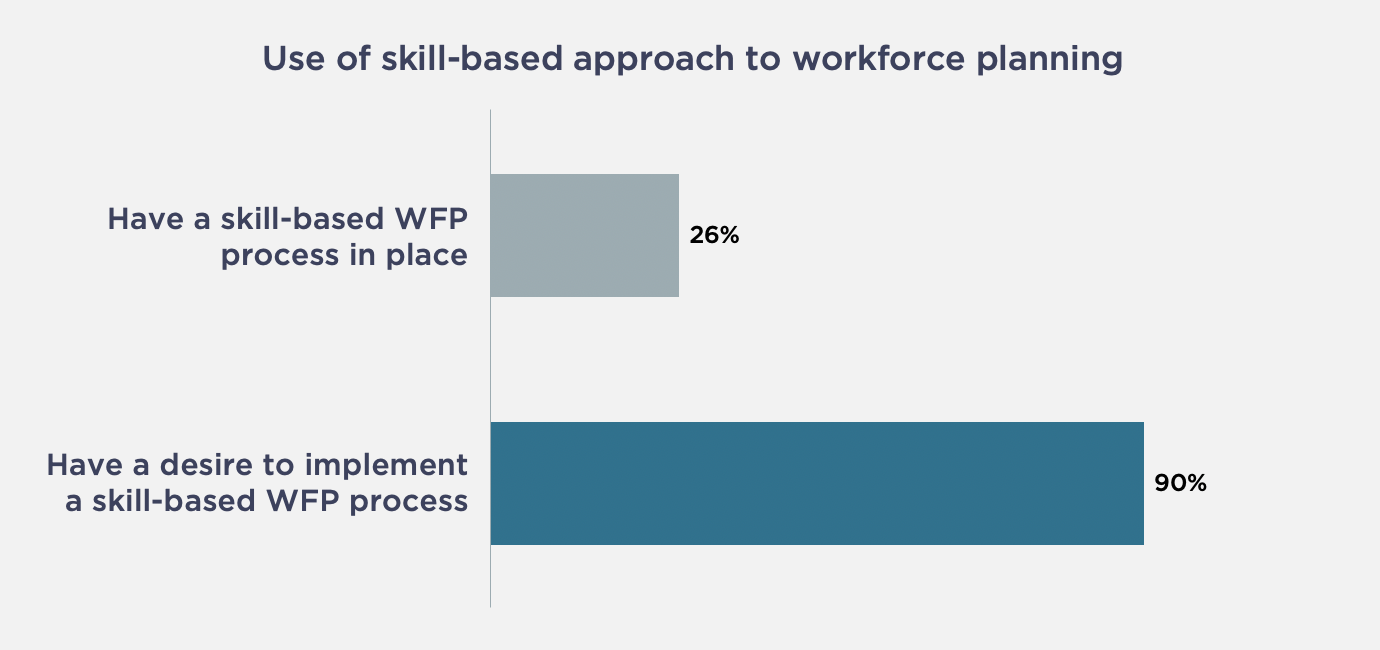Democratising Strategic Workforce Planning for Organisational Agility
As businesses grapple with economic uncertainties and the rapid pace of technological change, the need for agility in workforce planning has become more pertinent than ever. This is where strategic workforce planning (SWP) emerges as a beacon of light for organisations looking to navigate these evolving challenges and build a competitive advantage. It is an avenue for organisations to become more agile, allowing them to anticipate, respond to, and even leverage these uncertainties.
By aligning their human resources with their strategic goals, organisations can ensure they have the right people, with the right skills, in the right roles, at the right time, bolstering an organisation's resilience in the face of uncertainty and creating opportunities for growth and innovation.
However, the practical implementation of strategic workforce planning presents significant challenges for many organisations. Despite carrying out meticulous market analyses and understanding their organisational design and people planning needs, successfully executing these plans often becomes a stumbling block.
Even with the most comprehensive people analytics - rich with data and insights - if key stakeholders do not utilise this information effectively, the exercise becomes futile. It is, therefore, essential for organisations to not only generate and collate this data but also to ensure stakeholder buy-in to fully exploit the potential of their people planning efforts.
One of the key barriers to effective SWP adoption is the lack of democratisation. In other words, not empowering all levels of an organisation to participate in decision-making processes and access data that can inform their actions.
The Pitfalls of Neglecting SWP Democratisation
Ignoring the democratisation aspect of SWP can lead organisations down a path of short-sighted, reactive decision-making. Co-founder of eQ8, Chris Hare's concept of upstream thinking, is pivotal here, encouraging organisations to look beyond immediate challenges and consider the underlying causes and long-term implications.
On the Digital HR Leaders Podcast, Chris Hare presents an excellent analogy to illustrate this concept.
“One of the analogies that we quite gravitate to is the idea that the three of us are sitting by a river, and we see a child struggling in the water. If you dive in, David, and you bring that child to the riverbank, you're going to be a hero. We're going to be patting you on the back. And we see the next child, maybe I'll have a turn, maybe Alicia will have a turn. By the time we've gotten to 20 of those, we're all going to be pretty exhausted, but we'll be pretty proud of ourselves.
What we should do though is one of us should walk up the river bank, up river, and see who's throwing these kids in the water. If you can solve that, if you can figure that out, you're not going to have to save 20 more kids later that afternoon. But there are going to be 20 theoretical kids, no one's going to be able to point to them. So, unlike earlier when we were getting a medal for what we were doing, because you could tangibly see, and I'll put this in the workforce sense, "We were able to slash 10% of the workforce, so that saved us $5 million, yay".
This approach is particularly crucial in times of economic downturn or crisis. Recent research conducted by eQ8 and Aptitude Research revealed that 72% of organisations surveyed are under pressure to reduce their headcount. Therefore, with organisations tightening their purse strings, the need for a more thoughtful approach to workforce planning, one that negates the ill effects of reactive and short-sighted decision making.
Rather than simply reducing headcount, organisations need to consider the long-term impacts on their workforce and how these decisions will affect their capacity to rebound and grow when circumstances improve. This forward-thinking approach will not only help organisations weather the current storm but also prepare them to thrive in the post-crisis landscape.
Taking a Holistic Approach to Democratising SWP
To effectively democratise SWP, organisations need to embrace a holistic approach that involves all levels of the organisation. Chris Hare advocates for regular strategic sessions with leadership teams, stating, "It's not something that HR has to bang on the table and do every day. But certainly, once a quarter, we can stop for 90 minutes, two hours with the leadership team and say, "Let's revisit where we think this organisation's heading. Let's revisit how we best serve customers".
This also means including business leaders in scenario planning and utilising people analytics to guide strategic decisions. By involving stakeholders from all levels, organisations can gain a more comprehensive understanding of their workforce needs and capabilities, leading to better planning and decision-making.
In a separate podcast, Co-founder of eQ8, Alicia highlights,
"You saw that skill may be in demand for this market or this location or your competitor next door, but is it actually needed for your competitive advantage, your organisation with its value chain and strategic imperatives?"
This is why you need to include all leaders in the conversation and have frequent discussions with the business to ensure you're really making that connection and understanding what's going on. Otherwise, you could end up with a whole bunch of initiatives that don't align with your company's overall strategy.
To facilitate these discussions, you must put forward insights and conversations your stakeholders understand. And this is where investing in platforms that are easy to use and understand really helps. Yes, you could still achieve this with Excel, but this will take time and may deter business leaders from adopting SWP practices.
Communicating the Urgency to Leadership Teams
Communicating the urgency and benefits of strategic workforce planning is key to gaining buy-in from leadership teams. In times of crisis or economic downturn, organisations may be more receptive to adopting SWP practices. However, during "business as usual" scenarios, convincing leadership teams of the need for SWP can be challenging.
As Chris Hare succinctly puts it, the impetus for adopting Strategic Workforce Planning is twofold:
"It's about revenue, and second, it's about being a responsible employer."
Customer Retention
This statement is vital in demonstrating that SWP isn't merely a cost-cutting measure but a strategic tool that enhances an organisation's ability to adapt to customer demands and market changes. SWP is about customers and adapting to their ever-changing requirements. And if organisations don't have the capacity to fulfil these requirements, they will lose customers - and once you lose a customer, it is hard to get them back.
Employee Retention
Beyond customer retention, strategic workforce planning also plays a significant role in employee retention. Demonstrating responsibility as an employer is crucial to securing the trust and loyalty of your employees. Chris Hare provides a compelling perspective on this:
"Imagine you have a choice between working in two banks. One bank implements strategic workforce planning, while the other adopts an agile approach. Where would you feel more secure about your future over the next two to five years? Where do you think your role will be more thoughtfully considered? Most likely, you'd be more comfortable in the bank that thinks strategically about its workforce and your place in it. That's the kind of organisation I would want to work in."
This example sheds light on the importance of strategic people planning in creating a workplace where employees feel valued and secure, knowing that their employer is making informed, thoughtful decisions about the future of organisational design and its workforce.
Staying Ahead in an Evolving Field
As the World Economic Forum highlights, job positions and skills requirements are rapidly changing. By 2027, 23% of jobs as we know them today are expected to transform dramatically. This swift evolution will create 69 million new jobs, and a staggering 44% of individual worker skills will need to be updated in the same timeframe.
This impending shift underscores the urgency for a focus on skills-based workforce planning. With such a significant portion of the workforce needing to adapt, upgrade, and reorient their skills within a relatively short period, organisations must prioritise skills-based strategic workforce planning to remain competitive and resilient in the face of these imminent changes.
The future of work demands adaptability, and organisations need to act now to stay ahead of these changes. Don't wait to be asked by the business, but seize the opportunity and take ownership, proactively working on democratising SWP to keep on top of the changing world of work. Be the driving force in your organisation, and create a culture of continuous adaptation and improvement through strategic workforce planning.
The future is now, and it's up to HR and people analytics leaders to lead the way towards a more efficient, effective, and democratised approach to SWP that benefits both organisations and their employees.
Steering Towards a Future-Proofed and Agile Workforce
In conclusion, democratising strategic workforce planning requires a paradigm shift - moving away from traditional, siloed decision-making processes to a more integrated, inclusive approach. This shift involves adopting new technologies and analytical tools and, more importantly, fostering a culture of collaboration and open communication across all levels of the organisation.
The future of work is here, and as organisations brace themselves for the impending changes to the job market, it demands a new approach to workforce planning - one that is strategic, holistic and democratised. It's time to embrace this shift and invest in the tools, processes, and mindset that will drive long-term success for your organisation.
LEARN HOW TO USE DATA AND ANALYTICS TO UNDERSTAND THE SKILLS, OBJECTIVES, AND ACTIVITIES AVAILABLE IN YOUR ORGANISATION
Join the thousands already on myHRfuture Academy and delve into the foundations of data-driven organisation design and planning. Gain a comprehensive understanding of how to leverage data and analytics to optimise your workforce. This course covers the following key areas:
The foundations of data-driven organisation design and planning
Understanding the work to plan the workforce
How to manage and apply competency taxonomies
How to right-size your organisation
Download the full curriculum today and discover how myHRfuture can help you upskill for the future of work.



